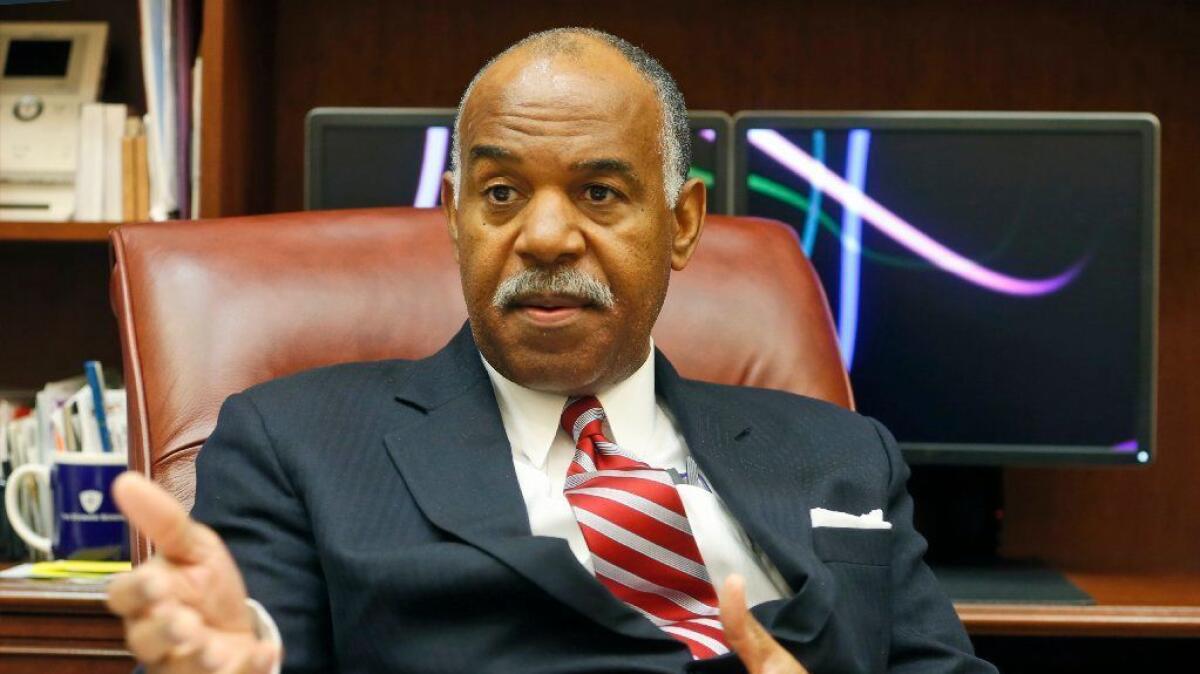Opinion: A court pays too much attention to Trump’s big mouth

- Share via
While President Trump was in Europe, some judges – he might call them so-called judges – on a federal appeals court in Richmond, Va., refused to reinstate the second version of his executive order temporarily limiting entry to the United States from a handful of majority-Muslim countries.
The decision may be poetic justice for a president who as a candidate stupidly proposed to ban all members of the Muslim faith from entering the United States. But it’s less impressive as actual justice.
Let’s be clear: As policy, it’s hard to defend the revised order. Although it’s less sweeping than the original version that caused chaos in airports in January by stranding travelers, its utility has been questioned by national security experts and it seems designed primarily to fulfill Trump’s promise to impose “extreme vetting” on people his base regards as potential terrorists.
But the question for the U.S. 4th Circuit Court of Appeals wasn’t whether the order was good policy but whether it raised serious enough constitutional questions that it should remain unenforced. On that question, 10 of 13 judges ruled against the administration.
Writing for the majority, Chief Judge Roger L. Gregory wrote that the order “in context drips with religious intolerance, animus and discrimination” and thus likely violates the 1st Amendment’s ban on an “establishment of religion.”
Gregory’s opinion is eloquent but unpersuasive. Reading it reminded me that among the many sins for which Trump will have to answer will be stupid utterances and initiatives that led judges to punish him with poorly reasoned rulings.
Gregory’s ruling essentially hangs on a familiar, and superficially plausible, argument: that the order is a sanitized version of Trump’s notorious proposal in December 2015 for a “total and complete shutdown of Muslims entering the United States until our country’s representatives can figure out what the hell is going on.”
In addition to the shutdown proposal, Gregory cites comments by Trump in interviews that “I think Islam hates us” and that America “can’t allow people coming into the country who have this hatred.”
These and other statements, Gregory concludes, are proof of “anti-Muslim sentiment” on Trump’s part. It was to effectuate that prejudice, not to protect national security, that the executive order was supposedly issued. That, the judge suggests, indicates “bad faith,” and Gregory notes that in a 2015 case Justice Anthony Kennedy indicated that courts may look beyond a “facially legitimate” exercise of the president’s immigration authority to detect an impermissible motive.
The court’s other evidence that the order was a pretext for religious bias is that some national security experts disputed the administration’s decision as to which countries whose residents it would temporarily prevent from coming to the United States. Gregory cites a friend-of-the-court brief by former national security officials that notes that no American had died as the result of a terrorist attack by a citizen of one of the six nations on the list in the last 40 years. This, Gregory said, proved that “ any national security justification for [the executive order] was “secondary to its primary religious purpose.”
Two problems here:
First, you can always find former officials who will dispute the wisdom of a particular administration’s policy when it comes to immigration or anything else. It’s possible that Trump’s executive order is stupid and ineffective and still within his authority – and still not a pretext for religious bias.
Second, the court is wrong, I think, in seeing Trump’s call for a temporary “shutdown” of Muslim immigration as a manifestation of religious hatred rather than an impulsive (and idiotic) exercise in what lawyers call over-inclusiveness.
The terrorists Trump was worried about were Muslims, so he decided to “err on the safe side” and propose to ban all Muslims. It was as if a politician in Britain in the 1970s or 1980s, when the IRA was committing horrific terrorist attacks there, proposed a temporary “shutdown” on Irishmen entering the UK. Also idiotic, but evidence of anti-Irish animus?
After Trump was rightly savaged for his absurd Muslim ban, he backed down and embraced a more targeted approach. He backed down again after the courts ruled against the original version of his executive order, removing, for example, language that seemed to provide a preference for Christian refugees. But the lesson of the 4th Circuit decision is that any official action he takes in the area of immigration will be judged on the basis of his most extreme campaign rhetoric.
That’s a really troubling legal standard. In his dissenting opinion, Judge Paul V. Niemeyer pithily explains why:
“Because of their nature, campaign statements are unbounded resources by which to find intent of various kinds. They are often shorthand for larger ideas; they are explained, modified, retracted and amplified as they are repeated and as new circumstances and arguments arise. And they are often ambiguous. A court applying the majority’s new rule could thus have free rein to select whichever expression of a candidate’s developing ideas best supports its desired conclusion.
“Moreover, opening the door to the use of campaign statements to inform the text of later executive orders has no rational limit. If a court, dredging through the myriad remarks of a campaign, fails to find material to produce the desired outcome, what stops it from probing deeper to find statements from a previous campaign, or from a previous business conference, or from college?”
Or, the judge might have added, from an episode of “The Apprentice”?
Follow the Opinion section on Twitter @latimesopinion and Facebook
More to Read
A cure for the common opinion
Get thought-provoking perspectives with our weekly newsletter.
You may occasionally receive promotional content from the Los Angeles Times.











